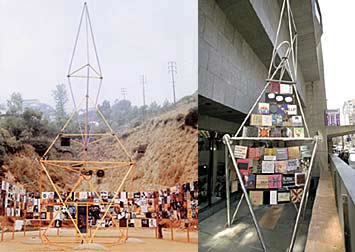Peace Tower at the Whitney Biennial

The Peace Tower is a powerful statement of protest. By constructing it outside the museum’s entrance for all to see, Mark and Rirkrit remain true to the spirit of the original.
The tower gives us a chorus of artists’ voices in a public reminder that art is being made in a world that is, in the words of Antonin Artaud, “a theatre of cruelty.”
So proclaimed Chrissie Iles and Philippe Vergne, the curators of the just opened 2006 Whitney Biennial. They were commenting on The Peace Tower, a collaborative work by Mark di Suvero, Rirkrit Tiravanija, and 180 other artists that is an updated recreation of the famous artist’s tower against the war in Vietnam, constructed in Los Angeles in 1966.
The question is, are American artists finally addressing the current state of world affairs in their artworks? One would have to say that at least some are, as the 2006 Whitney Biennial presents artworks full of references to Iraq, Abu Ghraib, Katrina, terrorism, and the abuses of government. The recreated Peace Tower stands just outside the Whitney Museum, setting the tone for the Biennial as it greets visitors with its antiwar message.
In 1966 the Artists Protest Committee organized the Peace Tower, which stood at the corner of Sunset and La Cienega Boulevards. The sculpture, designed by artist Mark di Suvero and Mel Edwards, was covered with over 400 small panels submitted by artists from all around the world. Each panel was an artistic antiwar statement, and some of the artists who submitted works include Leon Golub, Philip Evergood, Moses and Raphael Soyer, Robert Motherwell, Jim Rosenquist, Philip Pearlstein, Arnold Meshes, and Judy Chicago.
At the public dedication of the short lived monument against the war, dismantled after a few controversial months, there were speeches made by art critic and author, Susan Sontag, and Donald Duncan, an ex-Green Beret who said, “I am not here today to protest our boys in Vietnam. I’m here to protest our boys being in Vietnam.
In creating a new Peace Tower at New York’s Whitney Museum, some of the original 1966 artists like James Rosenquist were asked to submit works, but a good portion of the artists who have contributed to the latest effort, artists like Nancy Spero, Hans Haacke, Yoko Ono, and John Baldessari, had no association with the original LA tower. Mark di Suvero was of course one of the primary creators behind the 1966 Los Angeles tower project, and in producing a new tower that focuses on America’s latest imperial adventure, he’s helped to revitalize the activist spirit of contemporary art.
Reuters published an article on the new Peace Tower, which quotes Chrissie Iles, co-curator of the Whitney Biennial; “The anti-war sentiment among artists has been very strong, it’s what we felt everywhere, whether we were at an artist’s studio doing abstract paintings or whatever. It’s a general sense of anger that they feel, this sense of things falling apart.”
Reuters also quoted Philippe Vergne, who curated the show with Iles; “We’re not going to stop the war, but maybe it’s going to force people to think a little differently and not take things for granted. If art can change the world for one person, that’s good enough for me.”
The March 2006 newstand edition of Artforum Magazine has a long interview with Irving Petlin, Mark di Suvero, and Rirkrit Tiravanija about the Peace Tower, first conceptualized by Petlin and di Suvero in 1966. Petlin said of the project: “I hope the new tower will be as controversial as the old one was back then. Because, you know, indifference is almost worse than hostility.”
For more on the Whitney Biennial 2006, read Biennial in Babylon by Jerry Saltz, art critic for the Village Voice, who wrote; “It is difficult to approach the hard issues of the world, yet if we don’t let more of the world in our work it’s likely that the world will let less of our work into it.” Though I think the better quote from Saltz in his 2006 Biennial summation would have to be his facetious remark… “This biennial is positively un-American.“


